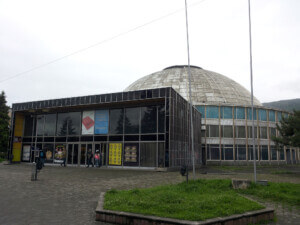The Architect’s Newspaper is partnering with USModernist to showcase its comprehensive archive of American modernist designers. This is the first post in a series that will highlight individual entries.
Paul Revere Williams was a Los Angeles–born, African-American architect who had an outsize impact on the region’s architectural legacy. Williams graduated from the University of Southern California in 1914 and eventually went on to design over 3,000 buildings over his five-decade-long career.
Los Angeles residents and visitors alike are likely familiar with the designer’s work, if not his name—a lasting legacy that only recently came into the spotlight. Williams was posthumously awarded the American Institute of Architects’ (AIA) 2017 Gold Medal—the organization’s highest honor, “recognizing individuals whose work has had a lasting influence on the theory and practice of architecture”—this year. For some, the recognition was thought to have come too late, especially in a field continually struggling with a lack of diversity.
Lack of recognition does not detract from greatness, however, and Williams was a titan of American design through and through.
As a young practitioner, he worked for architects Reginald Johnson and later John Austin, great architects in their own right. Williams became licensed in 1921, opening his own practice just a year later. He became the first African-American member of the AIA in 1923 and the first African-American AIA Fellow in 1957. Throughout his career, Williams worked across styles and locales, but it was his Modernist-style works that have persevered across time and still inspire us to this day.
Williams is perhaps best known, inaccurately, for his collaboration with William Pereira, Charles Luckman, and Welton Becket on the Theme Building at Los Angeles International Airport from 1961. The Googie-style building is considered to be among the most important midcentury modernist works in Los Angeles, though Williams did not help design it. The structure consists of a flat, disk-shaped observation and restaurant area suspended off the ground by a pair of intersecting, parabolic arches.
Some of Williams’s work is located outside Los Angeles, as well, including his collaboration with architect Quincy A. Jones on the Palm Springs Tennis Club and the La Concha Motel in Las Vegas, Nevada.
Williams was a virtuoso of architectural style, as best exemplified by the architect’s many residential projects. Williams’s efforts, attuned to Southern California’s finicky penchant for pastiche and historical revivalism, range in style from the Hollywood Regency to the Spanish Revival, and, of course, modernist treatments.
Williams was responsible for extensive interior and exterior renovations to the famed Ambassador Hotel in 1949. The architect worked on several renovations and additions to the Beverly Hills Hotel during the 1940s, including the iconic facade showcasing the hotel’s name in fanciful script.
Williams dabbled in socially-responsible work, too, and—along with Richard Neutra—was responsible for designing the garden city-inspired Pueblo del Rio public housing projects in 1941.
In a testament to Williams’s lasting legacy, eight of his works are listed on the National Register of Historic Places and many more are still standing across Southern California.
To read more about Williams, see his USModernist entry.










